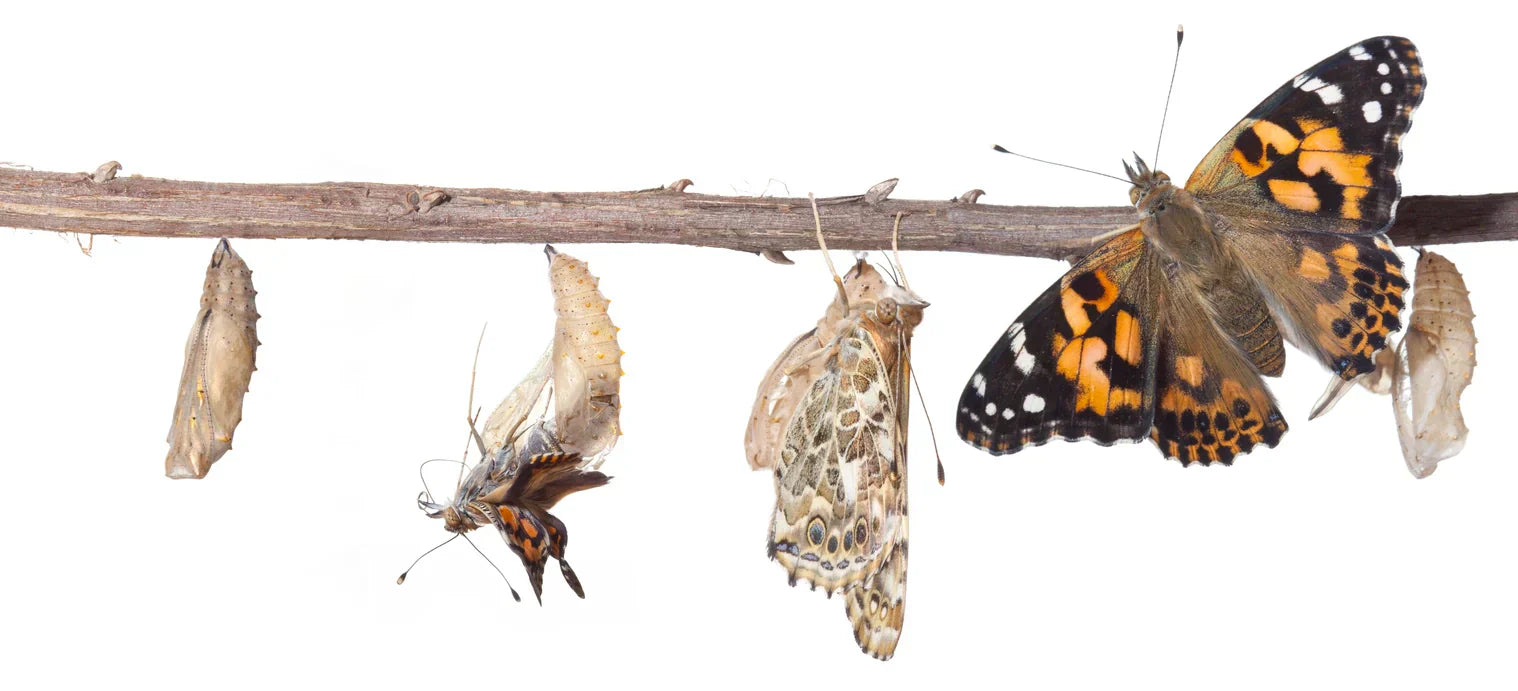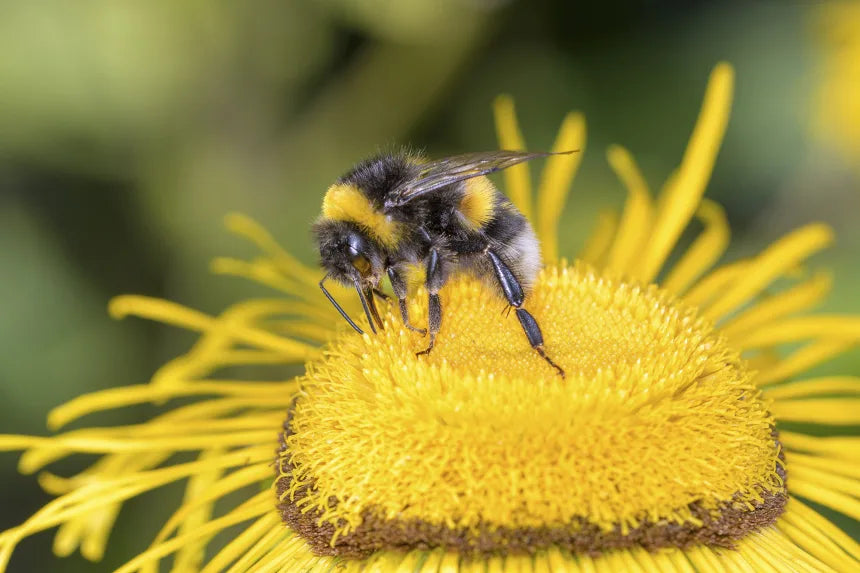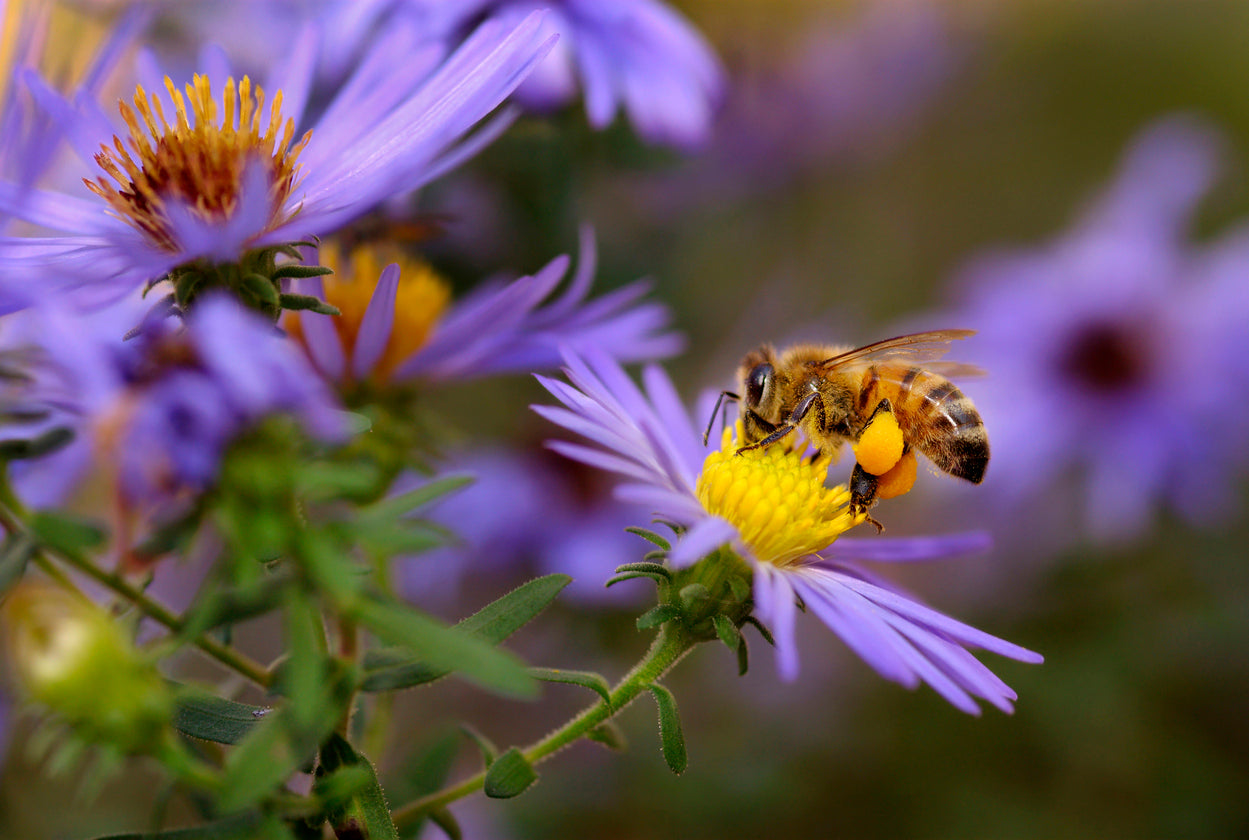Add description, images, menus and links to your mega menu
A column with no settings can be used as a spacer
Link to your collections, sales and even external links
Add up to five columns
Add description, images, menus and links to your mega menu
A column with no settings can be used as a spacer
Link to your collections, sales and even external links
Add up to five columns

Mating and Life Cycle of a Painted Lady Butterfly
By Spencer McManamna March 25, 2024 8 min read
In the enchanting realm of nature, there are few transformations that rival the captivating metamorphosis of the Painted Lady butterfly. From a tiny egg, to a crawling caterpillar, and finally a magnificent butterfly, the life cycle of the Painted Lady is a testament to the beauty and resilience of the natural world. Follow us on a fascinating journey through this remarkable insect's biology and uncover the mysteries of its captivating life cycle!
Painted Lady Butterfly Mating
Painted Lady butterfly reproduction follows a well-defined process, beginning with courtship rituals and culminating in the fertilization of their eggs. Male painted lady butterflies typically initiate courtship by locating a suitable mate through visual cues such as coloration and wing patterns. Once a potential mate is identified, the male will approach the female and engage in intricate aerial displays or physical interactions to demonstrate fitness and suitability. If the female is receptive, mating occurs, during which the male transfers sperm to the female's reproductive tract.
Laying Eggs
Following mating, the female painted lady butterfly will lay her eggs on host plants, typically those of the Asteraceae family, such as thistles and asters. The eggs are typically laid singly, attached to the underside of leaves, where they are left to develop and hatch. Once hatched, the Painted Lady Butterfly larvae, or caterpillars, emerge and begin to feed voraciously on the host plant, undergoing several instars of growth before pupation.
Asexual Reproduction
In contrast, asexual reproduction in other insects and animals can take various forms, such as parthenogenesis, fragmentation, or budding, depending on the species. Parthenogenesis, for example, is a form of asexual reproduction where offspring develop from unfertilized eggs. This process is observed in certain insects, such as aphids and bees, as well as some reptiles, amphibians, and fish.
Fragmentation
Another form of asexual reproduction is fragmentation, where an organism splits into two or more parts, each of which can regenerate into a new individual. This method is common in some species of flatworms, cnidarians (such as sea anemones), and certain types of algae.
Budding
Budding is yet another form of asexual reproduction, where new individuals develop as outgrowths, or buds, from the body of the parent organism. This method is observed in organisms such as hydra and some colonial marine invertebrates like corals.
While sexual reproduction in painted lady butterflies involves the fusion of gametes from two parents, resulting in genetic variation among offspring, asexual reproduction typically produces genetically identical offspring, providing advantages in stable environments but limiting genetic diversity and adaptability.
Continuous Mating
Continuous mating, also known as "remating," refers to the phenomenon where individuals engage in repeated mating encounters over a period of time. This behavior is particularly prevalent in species with extended breeding seasons or migratory patterns, where the availability of mates fluctuates due to factors such as population density, environmental conditions, and resource availability.
Migratory Flights & Continuous Mating (Remating)
In the context of painted lady butterflies, continuous mating plays a crucial role in their reproductive strategy, especially during their remarkable migratory journeys. Painted lady butterflies are known for their extensive migratory patterns, spanning vast distances across continents. These migratory flights are driven by the search for favorable breeding and feeding grounds, often influenced by seasonal changes in temperature and resource availability.
During their migratory flights, painted lady butterflies encounter varying densities of conspecifics (members of the same species) along their route. Continuous mating allows individuals to maximize their reproductive opportunities by mating with multiple partners encountered during their journey. This behavior is advantageous for painted lady butterflies as it increases the likelihood of successful fertilization and ensures genetic diversity within the population.
Furthermore, continuous mating can contribute to the genetic resilience of painted lady butterfly populations, particularly during long-distance migrations where individuals may encounter diverse environmental challenges and selective pressures. By engaging in remating, painted lady butterflies can potentially acquire genetic adaptations that enhance their ability to survive and reproduce in different habitats encountered along their migratory route.
Overall, continuous mating in painted lady butterflies reflects their adaptive reproductive strategy in the context of their migratory lifestyle. It highlights the intricate interplay between mating behavior, population dynamics, and environmental factors in shaping the reproductive success and genetic diversity of this fascinating species.
Painted Lady butterflies, are polygynous, which means one male will typically mate with more than one female. This behavior is relatively common in butterfly species but is rare in insects overall. Painted Lady butterflies will typically mate in the wide variety of environments they inhabit, such as hilltops, forests, and meadows.
Stage One: Painted Lady Butterfly Eggs
Painted lady butterfly eggs are small, cylindrical, and typically measure around 1 millimeter in length. They are characterized by their pale yellow or cream coloration, often appearing slightly translucent. The eggs have a ribbed or ridged surface texture, resembling miniature barrels or tiny ridged cylinders. They almost look like tiny watermelons!
Appearance
In terms of appearance, painted lady butterfly eggs can be described as elongated ovals with rounded ends. They are usually laid singly, rather than in large clusters, though multiple eggs may occasionally be found in close proximity on the underside of host plant leaves. However, it's important to note that painted lady butterflies are not known for producing large egg clusters like some other butterfly species.
Egg Clusters
Each female painted lady butterfly can lay hundreds of eggs throughout her lifespan, typically distributing them across multiple host plants to ensure the survival of her offspring. The number of eggs laid in an average cluster can vary depending on factors such as the availability of suitable host plants, environmental conditions, and the reproductive condition of the female butterfly. However, painted lady butterfly eggs are generally not found in dense clusters like those of certain other butterfly species.
On average, a female painted lady butterfly can lay anywhere from 200 to 500 eggs throughout her lifespan, which typically ranges from a few weeks to a couple of months. This means that while she may lay multiple eggs during a single egg-laying session, the number of eggs laid at one time is relatively small compared to some other butterfly species.
After a female painted lady butterfly lays her eggs, it takes approximately 3 to 5 days for the eggs to hatch under optimal conditions. The exact time to hatch can vary depending on factors such as temperature, humidity, and the health of the eggs.
Stage Two: Painted Lady Caterpillars (Larvae)
What was once a tiny egg is now a crawling and curious caterpillar! The larval stage of painted lady butterflies, also known as the caterpillar stage, typically lasts for about 10 to 14 days. However, the duration of the larval stage can vary depending on factors such as temperature, humidity, and the availability of food.
During this stage, painted lady caterpillars undergo rapid growth and development as they feed voraciously on the leaves of their host plants. They molt several times, shedding their exoskeletons to accommodate their increasing size. Each molt, or instar, represents a new stage of development, with the caterpillar gradually growing larger and more mature.
As the caterpillars near the end of the larval stage, they enter a pre-pupal phase where they cease feeding and become less active. During this time, they may wander away from their host plant in search of a suitable location to pupate. Once they find a suitable spot, the caterpillars attach themselves securely by spinning their own silk threads and undergo metamorphosis into pupae.
Stage Three: Painted Lady Butterfly Chrysalis (Pupa)

Take a look at this captivating chrysalis! The word chrysalis refers to the protective casing or shell that encloses the developing pupa. During metamorphosis, the caterpillar undergoes significant physiological and structural changes inside the chrysalis, ultimately transforming into an adult butterfly. Inside the chrysalis, the caterpillar's body undergoes a process called histolysis, where its tissues break down and reorganize to form the structures characteristic of the adult butterfly, including wings, antennae, and legs.
Chrysalis Appearance
In the case of the painted lady butterfly, the chrysalis is typically characterized by a smooth, cylindrical shape with a slightly tapered end. It is often mottled in color, ranging from pale green or yellow to brown, depending on environmental factors and genetic variation. The chrysalis is usually suspended from a silk pad or thread attached to a substrate, such as a twig or leaf, providing stability and protection during the pupal stage.
Within the chrysalis, the developing butterfly is relatively immobile, undergoing profound changes as it transitions from a larval form to an adult form. Over the course of about 7 to 10 days, the pupa undergoes metamorphosis, culminating in the emergence of the adult butterfly from the chrysalis.
Adult Painted Lady Butterfly
The Painted Lady will finally emerge from its chrysalis as a beautiful adult butterfly, with two wings, a head, abdomen and thorax, two compound eyes and a tubular proboscis. When it first emerges the Painted Lady's proboscis will actually be in two separate halves or strands. It will take several hours to slowly reform the proboscis before it is able to feed!
Butterfly Wings
Similarly, the butterfly's wings are initially soft, crumpled, and fragile. The newly formed wings need time to expand, dry, and harden before they become fully functional for flying! Typically, it takes about 1 to 2 hours for a painted lady butterfly's wings to fully expand and dry. During this time, the butterfly will hang upside down or cling to a vertical surface, allowing gravity to assist in the expansion of its wings.
The process is aided by the circulation of fluid through the veins of the wings, which helps to inflate and shape them properly. Once the wings have fully expanded and hardened, the butterfly will begin to flutter them slowly, gradually testing their functionality. After a brief period of testing and adjustment, the butterfly will be ready to take flight and begin its journey as an adult.
Sexual Maturity
In general, painted lady butterflies typically become sexually mature and ready to mate within a few days to a week after emerging from their chrysalis. During this time, the butterfly will engage in behaviors such as basking in the sun, feeding on nectar from flowers, and engaging in territorial displays to attract potential mates.
Adult Lifespan
The adult lifespan of a painted lady butterfly typically ranges from 2 to 4 weeks under optimal conditions. However, the exact duration can vary depending on factors such as environmental conditions, temperature, availability of food, and predation.
Reproduction
During their relatively short adult lifespan, painted lady butterflies engage in reproductive activities to ensure the continuation of their species. Female painted lady butterflies are capable of laying hundreds of eggs throughout their adult lifespan, which contributes to the next generation of butterflies. The frequency of reproduction depends on factors such as the availability of suitable mates, the abundance of host plants for egg-laying, and the physiological condition of the female.
Reproductive Cycle
Painted lady butterflies have a short mating and egg-laying period compared to some other butterfly species, often completing the reproductive cycle within a few weeks of emerging from their chrysalis. This rapid reproductive turnover is essential for painted lady butterflies, as it allows them to maximize their reproductive potential and ensure the survival of their offspring.
Overall, while painted lady butterflies have a relatively short adult lifespan, they are highly efficient at reproducing during this time, contributing to the population dynamics and genetic diversity of their species. Their ability to reproduce quickly and effectively is crucial for the survival of painted lady butterfly populations, particularly given the challenges they face in their natural habitats.
Related products
Also in Butterflies

Ultimate Guide to Pollinators
December 15, 2025 8 min read
Pollination is the transfer of pollen from an anther of a plant to the stigma of a plant, which makes fertilization and the production of seeds possible. Read on to discover the uniquely incredible world of pollination, which brings so many priceless gifts to our own world.

Tips for Implementing STEM Education in the Elementary Classroom
December 11, 2025 4 min read
In this article, we'll help explain practical strategies for bringing STEM into daily instruction and will explore specific butterfly-metamorphosis activities that enrich your students’ scientific understanding!

History of National Pollinator Month
December 11, 2025 4 min read
National Pollinator Month, observed every June, is dedicated to raising awareness about the essential role pollinators play in sustaining our ecosystems, agriculture, and global food supplies.

Enter Your Voucher Code Below
If you are experiencing difficulty redeeming your voucher on your desktop, please use a mobile device for a better redeeming experience.

We are unable to combine redemption fees. If you are redeeming 1-5 voucher codes, please complete separate purchases through our website for each voucher. If you are redeeming 6+ vouchers, please email us at customerservice@insectlore.com with your voucher codes and shipping address and we'll send you a custom invoice for payment.
Thank you for Redeeming your voucher!
You redeemed a $title

Don't miss this special one Time Offer.
Check the Box to Add this Special Offer to your Cart

Don't miss this special one Time Offer.
Check the Box to Add this Special Offer to your Cart
It looks like you are an Insect Lore UK/EU customer! You are visiting the Insect Lore USA website.
Click Insect Lore UK/EU website to be redirected to insectlore.co.uk.




